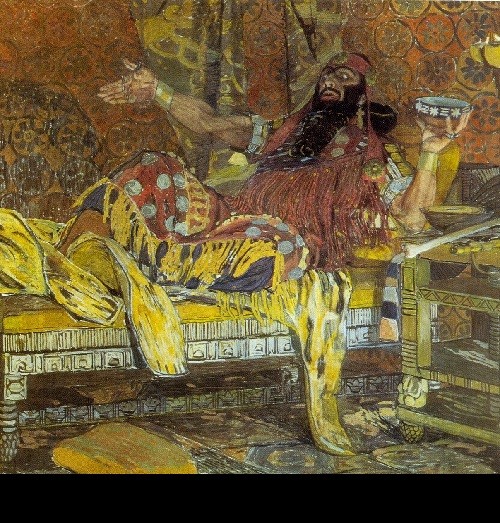
Moscow is replete with art galleries and museums. Yet there is one gallery that remains the symbol of Russian art – the world-famous Tretyakov Gallery. The founder of the gallery was the entrepreneur Pavel Tretyakov (1832–1898), who was from the merchant class. Beginning in 1856, Tretyakov made a hobby of collecting works by the Russian artists of his time. He was a famous patron of arts who helped support the peredvizhniki (literally, the travellers – a movement consisting of realistic painters in the second half of the 19th century). Toward this goal, he intended to purchase a collection from the Saint Petersburg collector, Fyodor Pryanishnikov, and, adding his own collection, to create a museum. The government bought Pryanishnikov’s Gallery in 1867, but Tretyakov gradually acquired an excellent collection, exceeding all other collections in Russia in its volume and quality.

In 1892, Pavel Tretyakov donated his entire collection to Moscow. His brother Sergey Tretyakov (1834–1892) was also a collector, but only of West European paintings. The brothers’ collections are at the core of the Moscow Municipal Art Gallery, which opened August 15, 1893. At first, it contained 1287 paintings and 518 pieces of graphic art by Russian artists, as well as 75 paintings by West European artists.
Later, the West European paintings of the Tretyakov Gallery were transferred to the Hermitage and the Pushkin Museum of Fine Arts, and the Tretyakovka (an endearing term used by Muscovites to refer to the gallery) began to specialise exclusively in Russian art. After 1918, Tretyakov’s collection grew many times over with the inclusion of the artist and art historian Ilya Ostroukhov’s (1858–1929) collection, paintings of the Russian school from the Moscow Rumyantsev Museum, and many private collections. A gift by Ivan Tsvetkov in 1925 – a huge collection of 2,000 paintings – was also a significant contribution.

More than 55 thousand works are kept there. It has a rich collection of ancient Russian icon painting of the 12–17th centuries, including Andrey Rublyov’s famous “Trinity” and significant works of painting and sculpture of the 18–19th centuries, as well as paintings by D. Levitskiy, Fyodor Rokotov, Karl Bryullov, Orest Kiprenskiy, Alexander Ivanov (including his well-known canvas “The Appearance of Christ to the People”), Ivan Kramskoy, and sculpture by Fedot Shubin.

The gallery has an excellent selection of the best works by the peredvizhniki: Ilya Repin (including “Ivan the Terrible and His Son Ivan”), Victor Vasnetsov, Ivan Shishkin, Vasiliy Surikov (“Morning of the Strelets Execution), Victor Vereshchagin and others. The blossoming of many areas of Russian art at the end the 19th and beginning of the 20th century is also well-represented.
The members of the “World of Art” and “Blue Rose” groups, and the Union of Russian Artists “Jack of Diamonds” made a name for Russian art not just in Russia, but also abroad. It suffices to name such painters and graphic artists as Mikhail Vrubel, Isaak Levitan, Nikolay Roerich, Alexander Benua, Mikhail Nesterov, Konstantin Korovin, Mikhail Dobuzhinskiy, Konstantin Somov, Valentin Serov, Boris Kustodiev, and Kuzma Petrov-Vodkin.

After a relatively short period of the 1910s–1920s, when new movements in art – futurism, cubism, etc. – were quickly developed, the Soviet government began to purposefully repress all artistic movements except for socialist realism. All the same, many artists did not lose their individual will to create, and they are well-represented in the Tretyakov Gallery by their best works. You will find, for example, Pavel Filonov, Aristarkh Lentulov, and Pyotr Konchalovskiy.
Indeed, even socialist realism, despite its officially sanctioned status, also produced a fair number of talented and original artists from the republics of the Soviet Union, such as Tair Salakhov (Azerbaijan) and Martiros Saryan (Armenia). Among the Russian socialist realists, Alexander Deineka, Arkadiy Plastov, Yuriy Pimenov (who borrowed much from the impressionists), Dmitriy Nalbandyan, and others.

The Tretyakov Gallery regularly has thematic and personalised exhibitions. In a branch of the Tretyakov Gallery located in the Central House of Artists there is a permanent exhibition entitled “Another Art,” which consists of the paintings of the 1920s through 1970s that could not be exhibited during the years of the Soviet Union because they did not coincide with the communist ideology. A significant number of works by the Russian avant garde from the first half of the 20th century were collected and donated to the Tretyakov Gallery by George Kostaki in 1978.
The main building of the gallery includes Tretyakov’s renovated home and several buildings that were attached to it at various times. The main facade of the building was erected in 1902 according to the plans by the artist Viktor Vasnetsov. In 1994, the Tretyakov Gallery opened after ten years of restoration. This was not just a facelift to the building; the interior and technical equipment were brought up to date with the highest levels of quality, which is as it should be, since it contains so many treasures of Russian art.
Russian art Tretyakov Gallery – photo
















